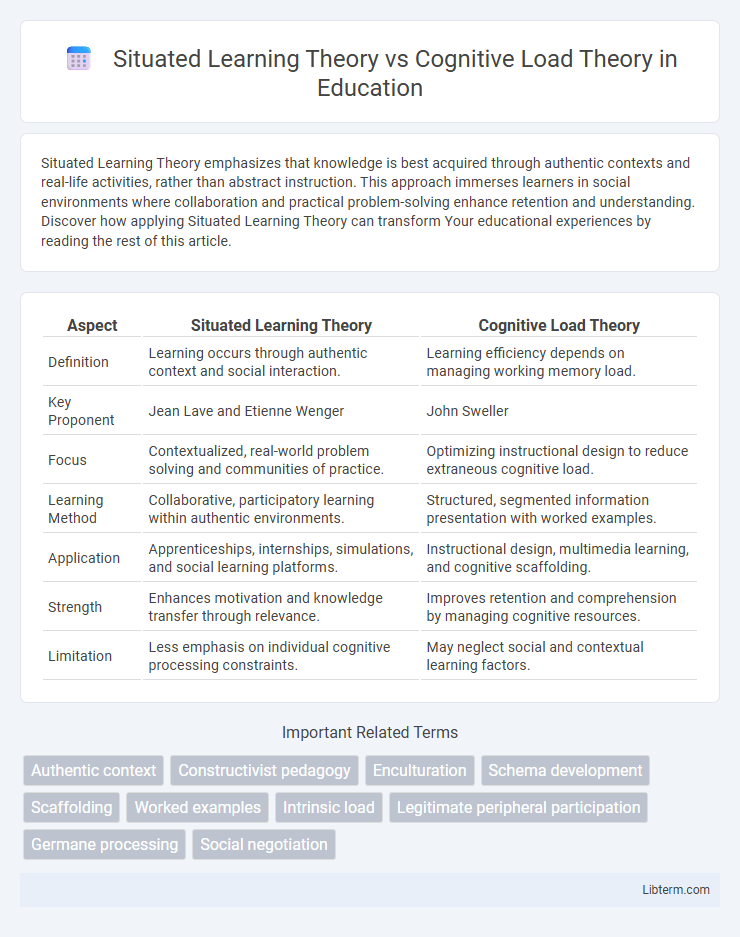Situated Learning Theory emphasizes that knowledge is best acquired through authentic contexts and real-life activities, rather than abstract instruction. This approach immerses learners in social environments where collaboration and practical problem-solving enhance retention and understanding. Discover how applying Situated Learning Theory can transform Your educational experiences by reading the rest of this article.
Table of Comparison
| Aspect | Situated Learning Theory | Cognitive Load Theory |
|---|---|---|
| Definition | Learning occurs through authentic context and social interaction. | Learning efficiency depends on managing working memory load. |
| Key Proponent | Jean Lave and Etienne Wenger | John Sweller |
| Focus | Contextualized, real-world problem solving and communities of practice. | Optimizing instructional design to reduce extraneous cognitive load. |
| Learning Method | Collaborative, participatory learning within authentic environments. | Structured, segmented information presentation with worked examples. |
| Application | Apprenticeships, internships, simulations, and social learning platforms. | Instructional design, multimedia learning, and cognitive scaffolding. |
| Strength | Enhances motivation and knowledge transfer through relevance. | Improves retention and comprehension by managing cognitive resources. |
| Limitation | Less emphasis on individual cognitive processing constraints. | May neglect social and contextual learning factors. |
Introduction to Situated Learning Theory
Situated Learning Theory emphasizes the importance of context and social interaction in the learning process, asserting that knowledge is best acquired through authentic, real-world experiences within a community of practice. It contrasts with Cognitive Load Theory by focusing less on individual information processing constraints and more on immersion in meaningful activities that develop practical skills and understanding. Key proponents such as Jean Lave and Etienne Wenger highlight that learning is inherently tied to participation and collaboration rather than isolated memorization.
Introduction to Cognitive Load Theory
Cognitive Load Theory (CLT) emphasizes the limitations of working memory during learning and aims to optimize instructional design to reduce extraneous cognitive load. Unlike Situated Learning Theory, which focuses on learning through authentic context and social interaction, CLT is grounded in cognitive psychology and targets efficient information processing. Effective instructional strategies based on CLT include segmenting complex material and using multimedia principles to enhance schema construction and knowledge retention.
Core Principles of Situated Learning Theory
Situated Learning Theory emphasizes learning through authentic context, social interaction, and collaboration within a community of practice. Core principles include legitimate peripheral participation, where learners gradually move from passive observation to active engagement, and the integration of knowledge and environment, making learning inherently tied to real-world activities. This contrasts with Cognitive Load Theory, which focuses on managing working memory capacity to optimize information processing during learning tasks.
Fundamental Concepts of Cognitive Load Theory
Cognitive Load Theory centers on managing working memory capacity by categorizing cognitive load into intrinsic, extraneous, and germane loads to optimize learning efficiency. Situated Learning Theory emphasizes learning through authentic contexts and social interactions, contrasting with Cognitive Load Theory's focus on internal cognitive processes. Understanding intrinsic load involves the inherent difficulty of the material, while minimizing extraneous load and enhancing germane load supports schema construction critical for long-term knowledge retention.
Key Differences Between Situated and Cognitive Load Theories
Situated Learning Theory emphasizes learning through authentic contexts and social interaction, while Cognitive Load Theory focuses on managing working memory limits during instruction. Situated Learning prioritizes real-world application and collaboration, whereas Cognitive Load Theory stresses instructional design to reduce extraneous cognitive load and optimize intrinsic and germane load. These differences underscore a contrast between context-based experiential learning and cognitive efficiency in knowledge acquisition.
Applications of Situated Learning in Education
Situated Learning Theory emphasizes learning through authentic contexts, social interaction, and collaboration, promoting deeper understanding by engaging students in real-world tasks and communities of practice. It is widely applied in education through project-based learning, internships, and apprenticeship models that immerse learners in meaningful experiences directly related to their field of study. These practical applications enhance motivation, contextualize knowledge, and foster critical thinking, contrasting with Cognitive Load Theory's focus on optimizing information processing by managing working memory during instruction.
Applications of Cognitive Load Theory in Instructional Design
Cognitive Load Theory (CLT) is applied in instructional design by structuring content to minimize extraneous cognitive load, thereby enhancing learners' working memory capacity and improving knowledge retention. Techniques include segmenting complex material into smaller, manageable chunks and using multimedia elements that align with dual-channel processing principles. Unlike Situated Learning Theory, which emphasizes learning in authentic contexts, CLT focuses on optimizing information presentation to reduce mental effort and facilitate efficient schema acquisition.
Strengths and Limitations of Situated Learning Theory
Situated Learning Theory emphasizes authentic context and social interaction, enhancing practical knowledge retention and skill transfer in real-world environments. Its strength lies in promoting collaborative learning and embedding knowledge within meaningful activities, but it can be limited by challenges in replicating authentic contexts and assessing individual learning outcomes rigorously. The theory may struggle to address abstract or decontextualized knowledge, where Cognitive Load Theory offers better structuring of information to manage learner cognitive capacity effectively.
Strengths and Limitations of Cognitive Load Theory
Cognitive Load Theory (CLT) excels in optimizing instructional design by managing working memory capacity to enhance learning efficiency, particularly in complex skill acquisition and problem-solving contexts. It clearly identifies intrinsic, extraneous, and germane cognitive loads, enabling educators to tailor materials that minimize unnecessary cognitive burden and maximize schema formation. However, CLT's limitation lies in its narrow focus on cognitive processes without sufficiently addressing social interaction or contextual factors, which are central to Situated Learning Theory's strengths in real-world, authentic learning environments.
Choosing the Right Theory for Effective Learning Experiences
Situated Learning Theory emphasizes learning through authentic contexts and social interaction, which enhances meaningful knowledge application. Cognitive Load Theory focuses on managing working memory limitations by optimizing instructional design to prevent overload and improve information processing. Selecting the right theory depends on learning objectives: use Situated Learning for real-world skill acquisition and Cognitive Load Theory for structured knowledge mastery and efficient cognitive processing.
Situated Learning Theory Infographic

 libterm.com
libterm.com